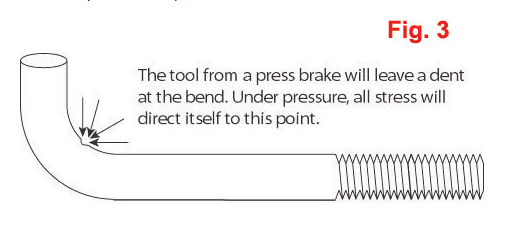One of the most overlooked factors in anchor bolt manufacturing is the bend in a hooked bolt. We’ve seen them done using a variety of methods, but the one to be careful with is the press brake.
All of the anchor bolts we manufacture in our Deer Park, NY factory, are manufactured to ASTM Specification F1554. This specification spells out everything necessary to make anchor bolts that will meet or exceed the engineer’s requirements. However, when addressing bending, F1554 does not indicate a method.
 F1554-07a sec 10.3 “Bend Section – The bent section of bent anchor bolts shall have a cross-sectional area not less than 90% of the area of straight portions.”
F1554-07a sec 10.3 “Bend Section – The bent section of bent anchor bolts shall have a cross-sectional area not less than 90% of the area of straight portions.”
Basically, this addresses only the diameter of the bar at the bend. It is obviously important that size at the bend diameter remain as close as possible to the straight portions. However, another problem that F1554 does not address is any impression or dent left on the inside radius by the bending tool.
Bent around a mandrel with consistent pressure applied through the bending process, the round bar will bend uniformly and leave no specific point of weakness. (see fig. 1) 
In the case shown in fig. 1, a 1-1/2” diameter Grade 55 round bar was bent around a perfectly round 3” diameter mandrel. This gives the hook an inside radius of 1-1/2”. The shiny area shows where the mill scale was rubbed off, but there is no one spot where and impression is centralized.
To understand why this is important visualize the interaction of the column, base plate and anchor bolts. ( fig. 2) When a column is put in place and the base plate is bolted down any movement at the top of the column will create uplift pressure (energy) on the anchor bolts as shown. In the case of a properly bent anchor bolt, that energy will disperse itself along the inside radius of the hook.
If the bend is done on a mandrel that is too narrow, or worse still pointed, it will leave a dent at the spot where it made contact. In an uplift situation, ALL THE ENERGY will focus on that single spot and dramatically increase the potential for failure.

Fig. 3 shows the stress focusing on the dented spot. Fig. 4 , which was evenly bent around a round and correctly sized mandrel shows how the stress will be evenly distributed.

At The Steel Supply Co., we manufacture hooked layout and straight layout anchor bolts and anchor bolt accessories that are made to ASTM Specification F-1554. To learn more about our anchor bolt products, click below.





